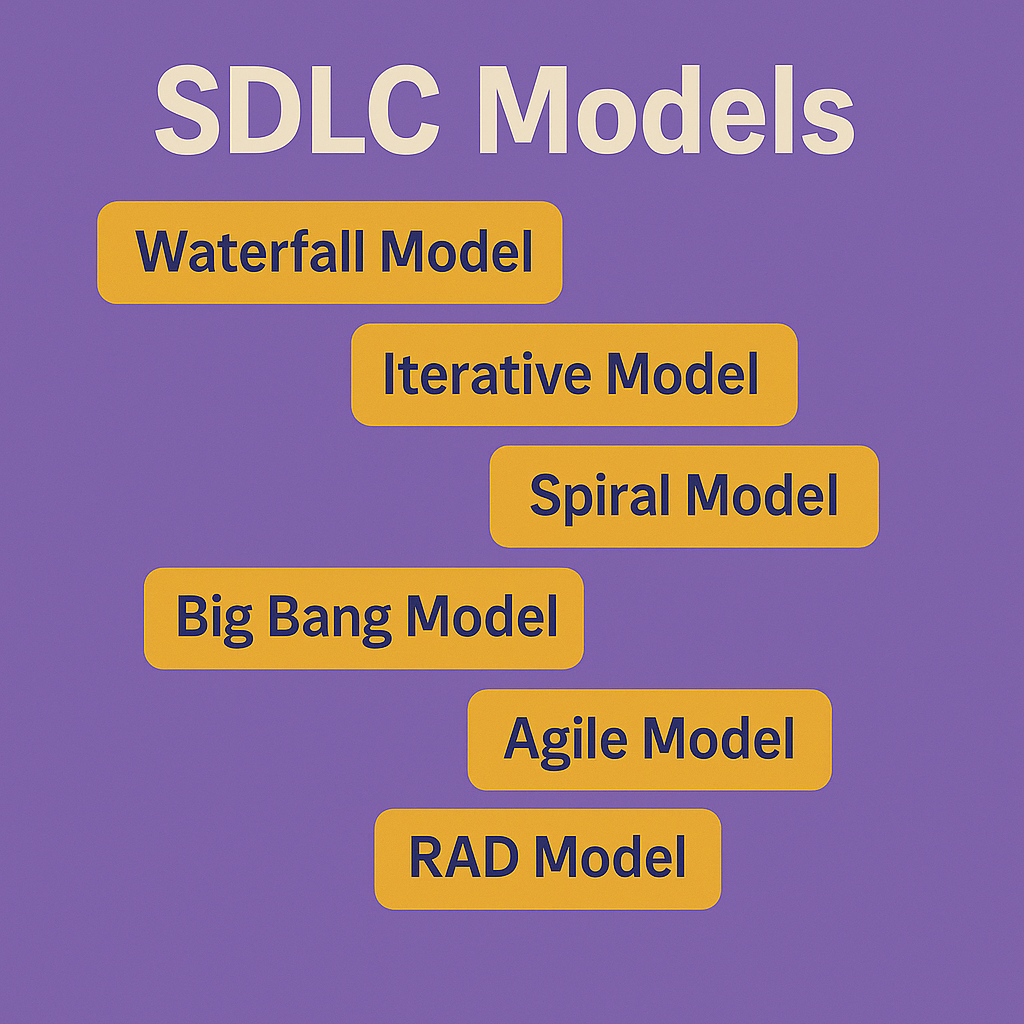SDLC – Overview
SDLC (Software Development Life Cycle) is a structured process used to develop high-quality software systematically. It includes steps like planning, designing, developing, testing, deploying, and maintaining software.
Think of it as a map that guides developers, testers, and managers to build software like building a house — step by step, with quality and structure.
Every project has different needs. That’s why various SDLC models exist, each with its advantages and best use cases.
1. SDLC – Waterfall Model
What is it?
The Waterfall Model is the oldest SDLC model. It works in a linear sequence — like a waterfall flowing down.
Steps:
- Requirements
- Design
- Implementation
- Testing
- Deployment
- Maintenance
Imagine writing a book. First, you plan the story. Then you write it. Then you edit. You can’t go back and change the plot after printing — that’s the Waterfall.

When to Use:
- Requirements are clear from the beginning.
- No chance of major changes later.
Pros:
- Simple and easy to understand
- Clearly defined stages
Cons:
- Not flexible
- Costly to make changes later
2. SDLC – Iterative Model
What is it?
Instead of building everything at once, you build a small part, test it, improve it, and repeat. Each cycle adds more features.
Building a restaurant in stages. First, you build one room, test if customers like it, and then build more.
When to Use:
- Requirements evolve over time
- Project needs frequent feedback
Pros:
- Fast delivery of partial software
- Easier to manage risks
Cons:
- Requires more time for planning iterations
- May result in rework
3. SDLC – Spiral Model
What is it?
A combination of Iterative + Risk Management. Each spiral loop includes planning, risk analysis, engineering, and evaluation.
Imagine a rocket launch. You test small modules first. Each round you go deeper, but also check risks — weather, engine issues, etc.

When to Use:
- Complex, high-risk projects
- Where you need frequent risk assessment
Pros:
- Excellent risk handling
- Highly customizable
Cons:
- Expensive and time-consuming
- Requires expertise
4. SDLC – V-Model (Validation and Verification Model)
What is it?
An extension of the Waterfall Model. Every development phase is matched with a testing phase.
Like cooking a dish and having a taster ready to test every step: test ingredients, test taste after boiling, etc.
When to Use:
- When testing is crucial
- When requirements are stable
Pros:
- Bugs are caught early
- Better quality assurance
Cons:
- Not flexible
- Changes are hard to accommodate
5. SDLC – Big Bang Model
What is it?
There is no specific plan. Just start building, and adjust as you go. Used for very small projects or prototypes.
Like painting without sketching. Just take a canvas and start.
When to Use:
- Small projects with small teams
- Research or proof-of-concept work
Pros:
- Very flexible
- Minimal planning needed
Cons:
- High risk of failure
- No guarantee of proper output
6. SDLC – Agile Model
What is it?
Agile divides work into sprints — short, time-boxed periods (like 2 weeks) with a clear goal. Continuous feedback from customers helps evolve the product.
You open a tea stall. Each day, you try a new flavor and ask customers: “Did you like it?” Based on feedback, you improve daily.
When to Use:
- Projects needing continuous change
- Customer feedback is crucial
Pros:
- Customer-focused
- Fast, adaptive, flexible
Cons:
- Requires discipline and experienced teams
- Documentation is light
7. SDLC – RAD Model (Rapid Application Development)
What is it?
A fast model focused on prototyping and quick feedback over long planning.
You want to build a custom bicycle. Instead of planning for months, you quickly build a prototype and ask: “Is this what you want?” Then improve.
When to Use:
- Projects that need to be built quickly
- You can involve users regularly
Pros:
- Very fast development
- User involvement improves accuracy
Cons:
- Needs strong team collaboration
- Not suitable for large, complex systems
Final Thoughts
SDLC is like a GPS for your software journey — and each model is a different route.
Here’s a Quick Summary:
| Model | Best For | Flexibility | Risk Handling |
|---|---|---|---|
| Waterfall | Clear, fixed requirements | Low | Low |
| Iterative | Evolving projects | Medium | Medium |
| Spiral | Risk-prone, critical systems | High | Very High |
| V-Model | Testing-heavy environments | Low | Medium |
| Big Bang | Very small, experimental ideas | Very High | Very Low |
| Agile | Dynamic, customer-centric apps | Very High | High |
| RAD | Need for speed and prototyping | High | Medium |
This article helps students, developers, testers, and project managers understand all SDLC models easily, with real-world stories.
Click here to read: www.techrhym.com/blog

